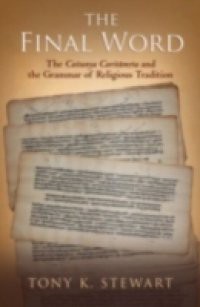In the early sixteenth century, a charismatic Bengali Brahmin, Visvambhara Misra, inspired communities of worshipers in Bengal, Orissa, and Vraja with his teachings. Misra took the ascetic name Krsna Caitanya, and his devotees quickly came to believe he was divine. The spiritual descendents of these initial followers today comprise the Gaudiya Vaisnava movement, one of the most vibrant religious groups in all of South Asia. In The Final Word, Tony Stewart investigates how, with no central leadership, no institutional authority, and no geographic center, a religious community nevertheless came to define itself, fix its textual canon, and flourish. The answer, he argues, can be found in a brilliant Sanskrit and Bengali hagiographical exercise: the Caitanya Caritamrta of Krsnadasasa Kaviraja. Written some seventy-five years after Caitanyas passing, Krsnadasas text gathered and synthesized the divergent theological perspectives and ritual practices that had proliferated during and after Caitanyas life. It has since become the devotional standard of the Gaudiya Vaisnava movement. The texts power, Stewart argues, derives from its sophisticated use of rhetoric. The Caitanya Caritamrta persuades its readers covertly, appearing to defer its arrogated authority to Caitanya himself. Though the text started out as a hagiography like so many others-an index of appropriate beliefs and ritual practices that points the way to salvation-its influence has grown far beyond that. Over the centuries it has become an icon, a metonym of the tradition itself. On occasion today it can even be seen worshiped alongside images of Krsna and Caitanya on altars in Bengal. In tracing the origins, literary techniques, and dissemination of the Caitanya Caritamrta, Stewart has unlocked the history of the Gaudiya Vaisnavas, explaining the improbable unity of a dynamic religious group.

















